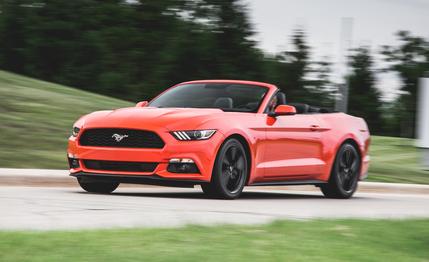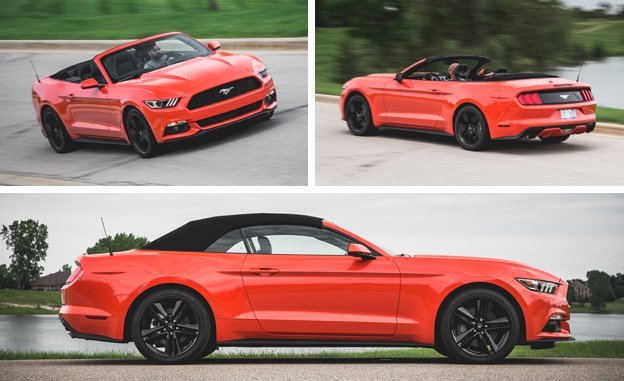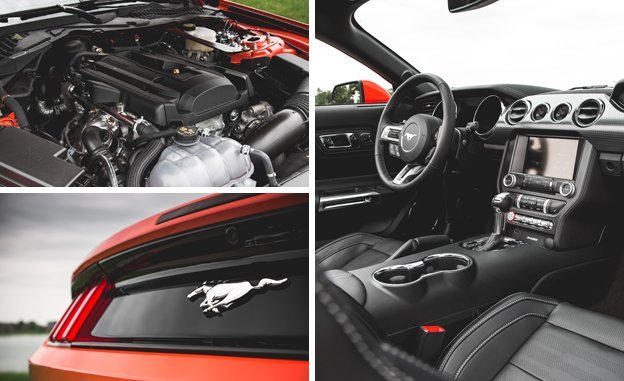
 Instrumented Test
Instrumented Test
Ford’s push for its EcoBoost agenda—the one where turbocharged, small-displacement engines can supposedly replace larger, naturally aspirated engines with improved fuel economy and no impact on power—turned to a shove when it added a turbo four-cylinder to the new Mustang’s engine lineup. A turbo four in America’s pony car, dadgummit?! The experiment worked out okay in the Mustang coupe, at least according to our instrumented testing, but the 133-pounds-heavier Mustang convertible is the straw that breaks the EcoBoost’s back.
Every EcoBoost-powered Ford that we’ve tested, Mustang or otherwise, has either delivered decent fuel economy (the three-cylinder Fiesta and Focus, for example) or served up great power (like the twin-turbocharged 3.5-liter V-6 in the F-150)—but never both simultaneously. The EcoBoost installed in the droptop Mustang delivers neither, being both the slowest 2015 Mustang we’ve tested while also not being particularly efficient. The manual- and automatic-equipped EcoBoost-powered Mustang coupes are quicker than this car’s 6.1 seconds to 60 mph by 0.6 and 0.9 second, and the 21 mpg we recorded during the convertible’s test is 1 mpg lower than we saw in a 2015 Mustang V-6 with the automatic transmission. Oh, and that V-6, which gives up 10 horsepower and 40 lb-ft of torque to the EcoBoost, still yanks the Mustang to 60 mph in 5.5 seconds. Heck, a last-generation Mustang V-6 convertible we rented outran this EcoBoost.


The EcoBoost engine never feels like it’s making 310 horsepower and 320 lb-ft of torque, and calls for full throttle are answered with groaning indifference, a frustrating lack of urgency above and below the 3000-rpm torque peak, and turbo whoosh so loud you’ll swear there’s an air hose under the hood. Not every sporty car has to crack the five-second barrier to 60 mph or lay down sub-12-second quarter-mile runs, but the Mustang driver will need the turbo’s racket to mask his or her whimpering shame when Volkswagen GTIs and Honda Accord V-6s display their taillights in stoplight drag races.
Which brings us back to why, exactly, you’d choose this engine. You could forgo the EcoBoost for the V-6, but Ford rigs that ballot: The cheaper V-6 Mustangs are restricted to but a handful of options—no navigation, no heated and cooled seats, and none of the performance-enhancing goodies available on EcoBoost and V-8 models—essentially slapping them with Avis and Hertz barcodes from birth.
That has the effect of forcing many buyers up to the EcoBoost, which starts at $35,700. With options, our turbocharged convertible rang in at an as-tested price of $43,365.


This is particularly frustrating in light of the rest of the convertible package’s general excellence. The electrically assisted steering is accurate and informative in each of its three driver-selectable settings, and body control is just as well managed here as it is on other 2015 Mustangs. The only real vice is a tendency for the dashboard and rearview mirror to slightly quiver to the beat of whatever road imperfections happen to be passing under the tires. In spite of the structural quibbles, we wrung 0.91 g of grip from the Mustang around the skidpad, while the responsive brakes brought the car to a stop from 70 mph in just 152 feet. Some credit goes to the 19-inch Pirelli P Zero summer tires, part of the $1995 Performance package that also includes a shorter 3.55:1 final drive, a limited-slip differential, and black-painted wheels. The $1195 six-speed automatic shifts intelligently, particularly with the gear lever in the S position, but it isn’t quick, making it even easier to catch the EcoBoost flat-footed or out of the boost, which makes taking full advantage of the balanced chassis a challenge.
It would be a treat to pair the Mustang’s full dynamic potential with the least-expensive engine, particularly since that engine is actually good, but that doesn’t fit Ford’s marketing scheme. The House of EcoBoost has acknowledged the 2.3-liter engine’s shortcomings to a degree and is working on a software fix to unlock more power that customers will be upgraded to under warranty in the coming months. For now, if you want a topless Mustang with lots of stuff and a nice engine, you’ll need to pony up a minimum of $42,700 to get into a V-8–powered GT droptop.